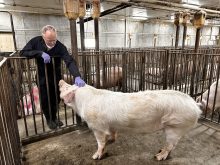The Merriam-Webster dictionary defines empathy as “the ability to share someone else’s feelings.” This differs from sympathy — feeling for the individual without actually experiencing their feelings.
Without a doubt, animals feel emotions. But do animals experience the feelings of another? In other words, can they feel empathy?
It’s a long-standing question that gets to the heart of what makes humans different from animals. Empathy has long been considered a uniquely human characteristic. It is also an essential pillar of human society, allowing us to organize, co-operate and interact with each other.
Read Also

Beef check-off collection system aligns across the country
A single and aligned check-off collection system based on where producers live makes the system equal said Chad Ross, Saskatchewan Cattle Association chair.
Back in the 1800s, British naturalist Charles Darwin had a side interest in animal consciousness, including empathy. And in modern times, there is growing evidence that animals do, in fact, experience empathy.
Psychology research suggests that empathy may have evolved before consciousness, the quality of awareness.
A simple example of empathy is parental care, whether in humans or animals. Parents who respond empathetically to the needs of their offspring by attempting to understand their experiences are more likely to raise those offspring to adulthood. More offspring can pass along their genes in the game of survival of the fittest.
More recently, scientists have attempted to study empathy in more controlled laboratory settings. This is not easy because animals cannot describe their inner-most thoughts. Instead, researchers must measure things that they can see.
For example, a 2011 study in the journal Science by researchers at the University of Chicago investigated empathy in laboratory rats.
In this study, researchers locked up one rat in a mini “rat jail” with another rat loose in an outer cage.
In less than a week, the free rats learned how to release those that were locked up. They did this by exploring the area around the jail until they learned to open the door.
But when the jail was empty or contained a toy rat, the free rats usually left the door closed. This demonstrated that the free rats deliberately released the jailed rat, and did not merely open the door out of habit or curiosity.
In the next phase, researchers modified the set-up so that the jailed rats were released into a separate area. The free rats still released the jailed rats.
This means that the free rats were not releasing their trapped friends for social contact.
The final test consisted of two jails, one containing a rat and the other chocolate chips, a desirable treat for humans and rats alike. The free rats continued to release the jailed rat.
But in a surprising twist, more than half the time, the free rat would share the chocolate chips with the jailed rats.
The researchers describe this food sharing as “pro-social behaviour” that indicates empathy. Free rats chose to release the jailed rats, even when they could not interact with them or when they would have to share the chocolate.
This means that the rats were compelled to release the trapped rats to reduce their distress.
Another key finding is that female rats were more likely to release the trapped rats and did so faster than male rats. This is consistent with research in people that suggests females have a greater ability to feel empathy.
This study is the first to concretely show empathy in so-called lower mammals. Since rodents are capable of empathy, it is likely other animals including domestic species share this trait. We just don’t know how to study it yet. Perhaps when one horse learns to open its own stall door and chooses to free the rest, there is more to it than a herd instinct to stick together. Maybe those Houdini horses actually want their stable mates to share in the fun.
Dr. Jamie Rothenburger is a veterinarian who practices pathology and a PhD student at the Ontario Veterinary College. Twitter: @JRothenburger

















